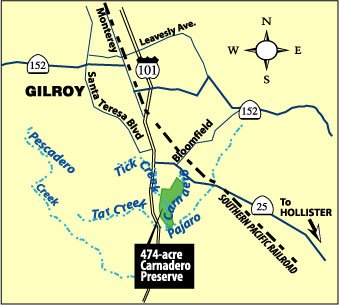GILROY
– More than 400 acres of farmland and willow-forested creeks
located south of Gilroy, north of San Juan Bautista and east of
U.S. 101 once were dangled below housing and retail developers’
noses.
GILROY – More than 400 acres of farmland and willow-forested creeks located south of Gilroy, north of San Juan Bautista and east of U.S. 101 once were dangled below housing and retail developers’ noses.
Now, a sale in the works to the Land Trust of Santa Clara County is expected to keep it green: partly for farming, partly for the diverse wildlife that live among its waters and trees and partly to serve as a much-needed natural flood plain in the Pajaro River watershed. When the winter rains fall, the fact that this area can flood with impunity may help reduce flooding farther downstream, in Monterey and Santa Cruz counties.
The Gilroy-based Land Trust is close to concluding a deal to buy the 474 acres for $6.8 million from owner Helen Wang, who originally bought the land with a profitable sale in mind.
The Land Trust plans to sell 198 acres – about 40 percent of the property – to the Santa Clara Valley Water District at the price it paid – $14,300 an acre – and sell the remaining 276 acres to a local grower for much less – $9,090 an acre.
The grower would have to agree to an agricultural easement, blocking any other non-ag use of the property, but in exchange would get the land at a price much lower than market rate.
“We provide a cost-effective means to maintain agricultural lands in production and provide solid economic incentives to landowners,” Land Trust President Don Gralnek said in a prepared statement Friday. “This project and the promise of our developing relationship with the Santa Clara Valley Water District is a win-win for all of us who are interested in affecting positive, thoughtful conservation in Santa Clara County.”
The property is commonly known as Lower Sargent Ranch. If the sale goes through, it would be called the Carnadero Preserve.
Across U.S. 101 is Upper Sargent Ranch, comprising 5,200 acres of ranchland slated for large-scale development if the owners can convince the county to change its “ranchland” zoning. Plans for that property have included two golf courses and up to 140 luxury homes.
Preserving farmland is a big concern of the Water District’s board, said Mike DiMarco, spokesman for the Water District.
“It’s not that the board is anti-development,” DiMarco said Monday. “It’s just that every time you allow development to move ahead unabated, it exacerbates water-quality problems and it increases the potential for flooding.
“This is the first purchase in the upper Pajaro watershed to keep that land out of development – the first of what we hope is going to be many,” DiMarco said.
The Water District will purchase the property with funds from its property-tax-funded Stream Maintenace program.
The bulk of the Carnadero Preserve would remain farmland; even the Water District would lease much of its portion to farmers. The Water District would retire some areas from agriculture – namely, within 150 feet on either side of the three waterways that run through the property: Carnadero, Tar and Tick creeks. Carnadero is known as Uvas Creek farther upstream, around Gilroy.
The Water District’s main reason for getting involved with this land purchase is to meet its mitigation requirements. Every time the District removes sediment from creeks to help them handle flood flows, repairs creek banks eroded by floods or removes non-native vegetation like tule reeds, it damages wildlife habitats. The state and national agencies that oversee the Water District require it to replace damaged habitat, usually with an area larger then the damaged area.
Given this task hanging over its head, the Water District saw the Carnadero land as a gold mine.
“Not only does it have wetlands,” DiMarco said, “but we found evidence of historic wetlands that we should be able to restore.”
Beyond this, Water District staff acted out of a general desire to preserve agriculture and natural habitats.
“We’re going to increase the protection of the stream resources,” Water District biologist Gale Rankin said.
One of those resources is the ability to flood. This 150-foot setback would allow natural flooding without threat to crops, potentially lessening flood water buildup downstream. The Water District is the agency responsible for flood protection in Santa Clara County.
Another resource is steelhead trout, a nationally threatened species, use Carnadero and Tar creeks as they migrate from the ocean in Monterey Bay to spawning grounds farther upstream.
Many land animals and birds also make their homes in the willow forest along the creek beds.














